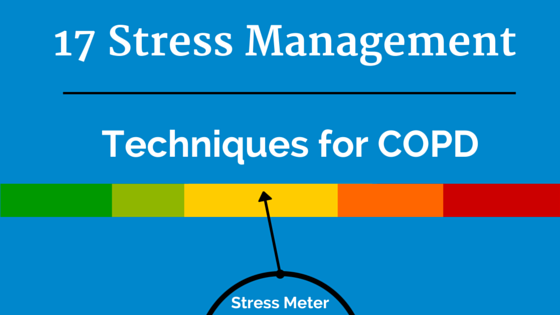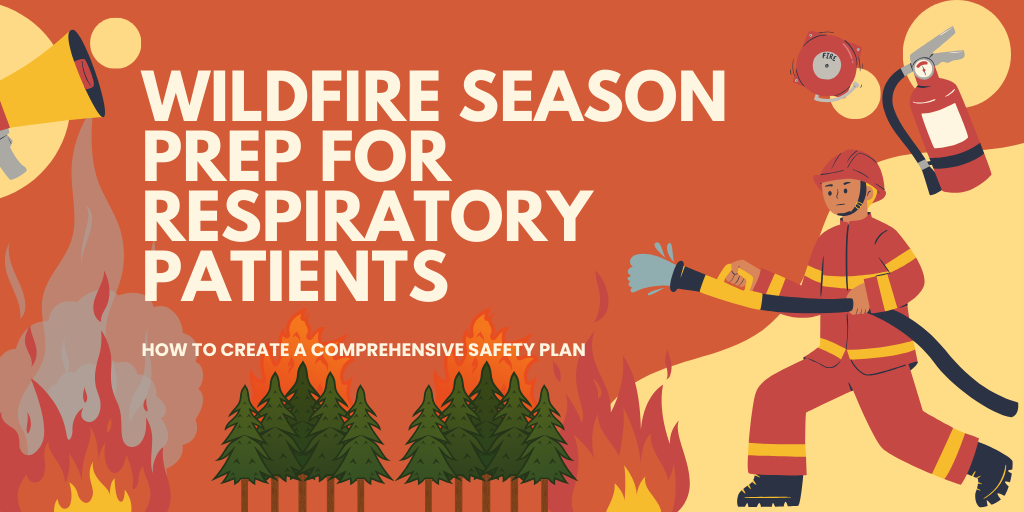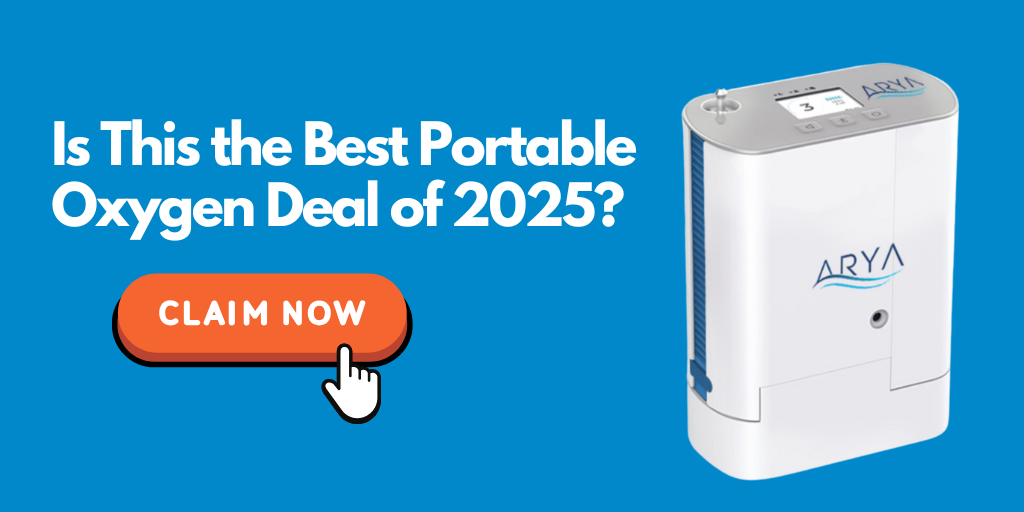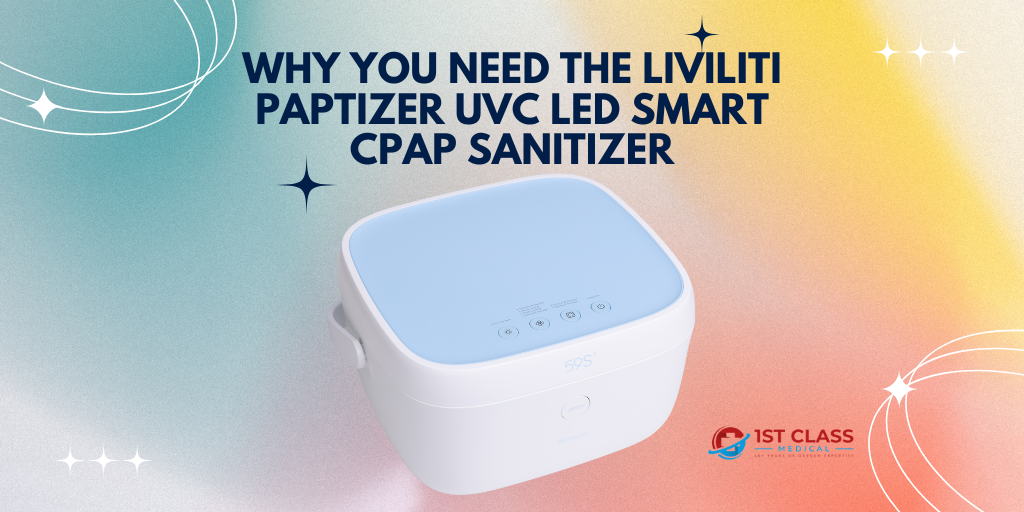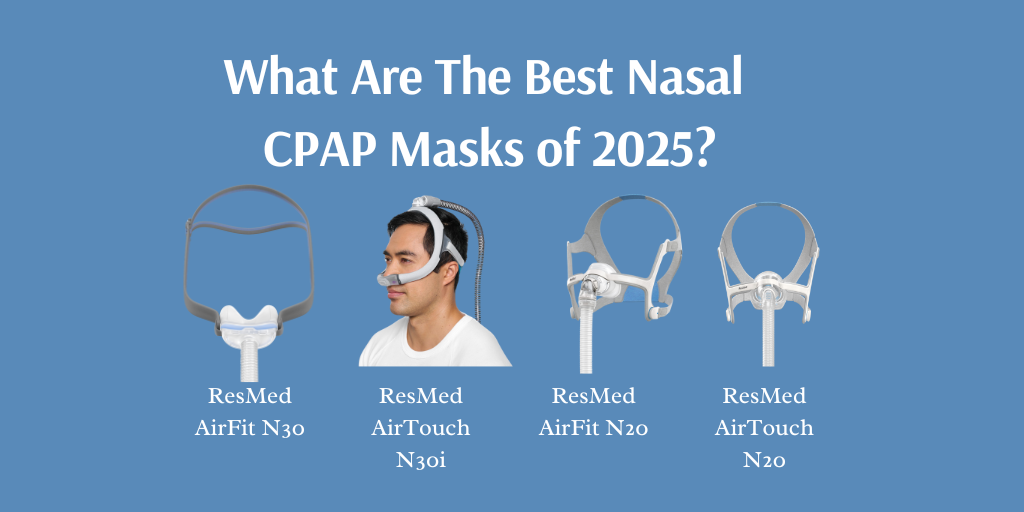How Exactly Does Stress & Anxiety Affect COPD?
When constant levels of high stress (chronic stress) and anxiety are thrown into the mix with COPD, even your best management efforts can be subsided. Stress weakens your already impaired immune system, leaving you more susceptible to symptom worsening infections. Additionally, stress levels can also enhance the severity of your shortness of breath and leave you at an increased risk for COPD worsening flare ups.
Leaving chronic stress untreated can lead to an endless cycle of anxiety. Causing your heart rate to increase, forcing you to take rapid breaths that only further worsen the severity of shortness of breath.
Assessing Your Personal Stress Triggers
When first beginning to treat or reduce your stress levels, you must first find the root cause(s) of your chronic stress, which are referred to as personal stressors:
- Work/Daily Activities - A noticeable reduction in your ability to get dressed, shower, run daily errands, or complete household chores. Other reasons include losing your job, retiring, or stress at work.
- Environmental - Moving to a new house or apartment. Air born irritants such as tobacco smoke, industrial workplace dusts and gases, welding fumes, areas with heavy air pollution, or cooking fire smoke.
- Personal - The development of COPD or a related lung infection, being handicap; change in self-esteem, emotional stress, financial status, habits such as sleep, nutrition, exercise, or smoking.
- Family/Friends - Divorce or termination of relationship, sexual difficulties, losing a friend or loved one, learning a friend/family member has an illness, or fighting with friends/family members.
The first step in treating and preventing chronic stress is to look at the 4 categories above and recognize what causes stress in your life. Be sure to take note and write down all of your COPD stressors, as this will help you in the long term. This would be a great time to start writing your panic diary, more on that later on.
3 Ways You React to Stress
Keep these stress reactions in mind, as we will refer to them frequently throught this post.
- Fear: This is a common feeling that occurs when faced with immediate danger.
- Anxiety: The feeling of constantly worrying and awaiting stressful situations.
- Panic Attack: An exaggerated fear or reaction to anxiety.
Stress Management Techniques for COPD Patients
1) Break the Anxiety-Breathlessness Cycle
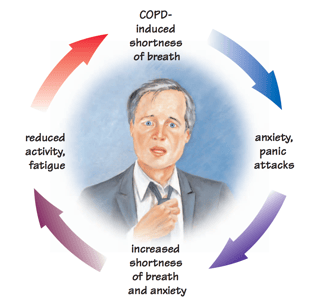
Whether you’ve recently been diagnosed or have stage 4 COPD, it’s very clear that the main symptom of COPD is breathlessness (shortness of breath). This is where the endless anxiety-breathlessness cycle begins. As the presence of even the slightest shortness of breath can cause your anxiety levels to skyrocket or even induce panic attacks.
Feelings of anxiety then cause your breathing rate to increase, adding to the severity of your shortness of breath, which then causes you to become anxious.
Starting to get the picture of how closely intertwined anxiety and COPD are? To help, lets break down the anxiety-breathlessness cycle:
- The main symptom of COPD, breathlessness, can cause anxiety and even panic attacks.
- Anxiety makes you breathe faster, further worsening shortness of breath that results in you becoming more anxious.
- The fear of worsening shortness of breath prevents patients from doing activities.
- Less activity results in declining physical condition, leading to increased fatigue, shortness of breath and anxiety.
Steps to Break the Anxiety-Breathlessness Cycle:
- Recognize Your Fears
- Examine the Root Cause of Your Fears
- Don't Worry About Events in the Future
- Practice Management Techniques and Plan for Stressful Situations
- Participate in Your Favorite Activities
- Go Slow and Solve One Problem at a Time
- Accept that You are Going to Make Mistakes and Learn from Them
- Always Maintain a Positive Attitude
2) Pet Therapy

Animal assisted therapy, also known as pet therapy, uses our favorite 4 legged furry friends to provide a therapeutic treatment for patients with COPD that experience frequent levels of stress and anxiety. Having the support of a pet can help boost your spirits and provide you with a source of joy. Additionally, providing you with a sense of importance knowing your support animal is dependent on you.
Pet therapy is already widely used to treat people with high anxiety disorders such as post traumatic stress syndrome (PTSD).
Additional Benefits of Pet Therapy:
- Noticeable improvement in social interaction
- Provides you with a reason to live
- Boosts your quality of life perception
- Temporarily reduces blood pressure
- Helps with feelings of loneliness
- Can help distract you from pain or COPD related symptoms
- Exercise partner
3) Yoga

Any physical activity is beneficial for COPD, however, yoga provides more than just improved respiratory function and fitness. This low-impact, mind-body form of exercise is also extremely efficient at reducing stress and anxiety caused by your chronic obstructive pulmonary disease.
What makes yoga an effective and COPD friendly method of exercise is its precise focus on physical posture and breathing techniques. The physical postures practiced in varying yoga poses can help increase your body’s range of motion, flexibility, balance, and overall strength.
What’s more, the focus on the diaphragmatic breathing technique will help you take control of your breathing while also teaching you how to use the power of your lungs to their fullest extent. Breathing techniques such as diaphragmatic breathing are used as you hold a pose and in a standalone practice.
By taking control of your breathing through yoga you will prevent the occurrence of the endless anxiety-breathlessness cycle. Furthermore, helping you to better manage stress levels. Allowing you to experience feelings of satisfaction despite the personal or disease complications you are experiencing.
Below are 5 COPD friendly yoga poses that you can do at home to help manage stress and anxiety:
- Sun Salutations
- Cat Pose
- Belly Breathing Pose
- Seating Spinal Twist Pose
- Triangle Pose
Additional Benefits of Yoga Include:
- Physical fitness improvements
- Lowered blood pressure
- Enhancements in self-confidence and relaxation
- Greater flexibility
- Improved balance, range of motion, and energy levels
4) Tai Chi

Tai Chi is another excellent form of meditation combined with light exercise that can help reduce chronic stress levels and can even be used to ease your COPD flare up. This mind-body exercise is a Chinese tradition that combines a series of slow and light movements with deep breathing techniques.
Resulting in a seamless motion that induces minimal muscle and respiratory strain. Furthermore, these movements cause your soft tissue to stretch allowing them to release built-up tension in your body. Providing you with feelings of calmness and pure relaxation. Tai Chi can also improve your exercise capacity, helping to increase energy levels, alleviate feelings of breathlessness, and enhancing your overall outlook on life.
COPD friendly Tai Chi exercises:
- Touch the Sky
- Windmill
5) Exercise Your Stress Away
You may already be aware of the incredible and many benefits that exercise provides for the treatment of chronic obstructive pulmonary disease. But have you ever thought of exercise as a stress reliever?
If not, we’re here to tell you that exercise is one of the most effective methods of stress relief. Exercise also provides additional benefits that include strengthening respiratory muscles, improvements in sleep and lifestyle quality, reduced fatigue, and weight management.
While being active a chemical known as serotonin is released by your brain. The increased levels of this feel good endorphin makes you feel happier, while providing you with a sense of satisfaction. Furthermore, exercise burns up stress causing chemicals such as adrenaline and cortisol, enabling you to relax and unwind with greater ease.
COPD Friendly Stress Relief Exercises to Try:
- Walking
- Jogging
- Jumping Rope
- Swimming
- Low Impact Aerobics
- Riding a Bike (Outdoors or Stationary)
- Chair Exercises
Be sure to use the pursed lip breathing technique during physical activity to better control your breathing and reduce the chances of a symptom worsening exacerbation.
6) Spend Time with Friends and Family

The most effective support system are friends and family, after all they care about your well being and will usually go the extra mile to help you in any way possible. All you have to do is ask. When stress or anxiety levels are heightened, ask a friend or family member if they can come over to talk. If that’s not possible due to living arrangements, at the minimum ask them to talk on the phone or video chat.
By talking to family or friends that you are comfortable with, you will be more likely to open up and express what is truly bothering you. Talking, laughing, crying, or expressing anger to someone you are close with is a healthy and effective way to deal with stress.
Breathing Techniques that Regulate Breathing Patterns
- Pursed Lip Breathing
- Diaphragmatic Breathing
Before we go into stress reducing breathing exercises, it’s important for us to bring up pursed lip breathing and diaphragmatic breathing.
As both can be applied during the onset of shortness of breath to help regulate your breathing patterns, and can be used in combination with many of the stress reducing techniques discussed for greater effectiveness. Lets briefly discuss how to properly perform these must know breathing techniques:
Pursed Lip Breathing:
- Step 1: Find a chair and sit up straight, a dining room chair typically works the best.
- Step 2: Take a deep breath, inhaling through your nose for 2-5 seconds.
- Step 3: Act as if you are going to whistle to “purse” your lips.
- Step 4: Using pursed lips, exhale for three times as long as your inhalation period. Avoid forcing the air out.
Diaphragmatic Breathing:
- Step 1: Lie down on your back with your knees bent, and keep your feet firmly planted.
- Step 2: Place one hand on your abdomen and the other on your upper chest.
- Step 3: Inhale through your nose, followed by exhaling through your mouth. Repeat for 3 cycles.
While performing diaphragmatic breathing, ensure that the hand on your stomach is only moving while inhaling. It’s important that you practice to keep your chest as still as possible and to only use your stomach to breathe.
7) Deep Breathing Exercises
You should now be well aware of the negative effects stress has on your COPD, specifically how it is a leading cause of flare-ups. Chronic stress levels can cause your shortness of breath and cough to worsen. Something you want to be sure to avoid, but how? By trying one of the following deep breathing exercises.
Simple Breathing Exercise
If you are experiencing high levels of stress or anxiety, take a step back and give yourself some time to perform the Simple Breathing Exercise:
- Step 1: Sit down in a chair or find a comfortable position laying down.
- Step 2: Close your eyes to go into a state of calmness and relaxation.
- Step 3: Inhale deeply through your nose and hold it for for 2-3 seconds.
- Step 4: Exhale through your mouth with pursed lips for 4 seconds.
- Step 5: Repeat as many times until you feel stress levels decreasing.
The 4-7-8 Breathing Exercise
The 4-7-8 breathing technique is possibly the easiest of all 3, due to the fact that there is no equipment required and you can do it wherever you are. It’s now time for you to apply the 4-7-8 technique for your stress reduction needs. This stress relief technique can be done in any position but is most effective with a straight back:
- Step 1: Make a whooshing sound while exhaling air.
- Step 2: Keep your mouth closed, slowly and silently inhale through your nose for 4 seconds.
- Step 3: Hold your breath for 7 seconds, then exhale completely with pursed lips.
- Step 4: Once again inhale and make a whooshing sound.
- Step 5: Repeat the 4-7-8 exercise until you feel relaxed.
Dr. Andrew Weil demonstrates how to properly perform the 4-7-8 breathing exercise:
Bellows Breath (The Stimulating Breath)
For the third and final stress reducing breathing exercise, we’d like to introduce the bellows breath, which is also referred to as the stimulating breath. Originating from ancient yogi practice, Bellows Breath is not only an effective stress reliever but it can also magnify your overall vitality level.
Practice bellows breathing by following the steps below:
- Step 1: Sharply inhale through your nose and keep your mouth closed in a comfortable position.
- Step 2: Hold your breath for 2-3 seconds, followed by slowly yet continuously exhaling through your mouth with pursed lips.
- Step 3: Repeat in 15 minute intervals when you are first starting to use the bellows breath.
In order to enjoy the full benefits of bellows breathing, you must pay precise attention to the rhythm of your breathing while inhaling and exhaling.
Practice until you are able to have a seamless and in sync rhythm. After continuous practice, your goal should be to increase the intervals by 1 minute each week until you have reached your personal limit.
Dr. Weil demonstrates the stimulating breath exercise:
8) Progressive Muscle Relaxation
The purpose of progressive muscle relaxation (PMR) is to teach you how to let go of the tension affecting your body to provided you with a total sense of relaxation. This is done by progressively constricting and releasing various muscle groups throughout your body to help calm your anxious mind.
Follow the steps below to properly perform progressive muscle relaxation:
- Step 1: Get into a comfortable position, away from any distractions.
- Step 2: Take a deep breath through your nose, focusing on the feeling of your abdomen rising as it fills with air. Exhale through your mouth with pursed lips.
- Step 3: Begin to slowly tighten and release your muscles, you may choose to start at your feet and progressively work up to your neck or vice versa. Tightly tense your muscles for a few breaths, then release.
- Step 4: Continuously work your way up/down your body, tightening and releasing each muscle group. Just make sure to hold your breath while tightening each muscle group.
- Step 5: Repeat for any areas that are excessively tight.
At the conclusion, you should take a few deep breaths and take note of your enhanced feelings of calmness and relaxation.
If you are not immediately able to feel improvements, don’t give up and continue to practice progressive muscle relaxation several times a week. Once you master the progressive muscle relaxation technique, you will be able to quickly put it into action to relieve tension whenever feelings of anxiety arise.
9) Visualization - Guided Imagery

Visualization, or guided imagery, is a form of mental meditation that you can use to help relax and reduce anxiety. Your mind is a powerful tool, but the presence of anxiety causes fearful and panic attack inducing thoughts.
To effectively perform guided imagery, isolate yourself in a quiet and peaceful room. Begin by slowing your breathing rate using one of the deep breathing exercises. Now, sit or lay down in a comfortable position and close your eyes while releasing any tension throughout your body. Now use your imagination to visualize yourself in a tranquil environment such as on a beach or even one of your favorite memories. Do this for 15 minutes, uninterrupted.
It’s important to focus on the finer details of your visualization, such as the warm weather, the feeling of sand in-between your toes, the tranquil sound of waves crashing, or maybe the joy of being with a friend or loved one. This low effort technique causes the tension in your neck, face, forehead, and throat to be released. Providing you with feelings of total relaxation.
Position your mental thoughts from a pessimistic state to an optimistic outlook. Dwelling on worries and fears will only make your life with COPD worse. Using the visualization technique will help you better seek solutions to problems and help remind you of all the positive things in your life. Perception is a key factor in combating the overall effects of stress.
10) Reengage in Your Favorite Interests and Hobbies/Find New Ones
Upon the diagnosis of your COPD, you may have completely halted participating in your favorite interests and hobbies due to shortness of breath, chronic stress, or the constant anxiety of exacerbating symptoms. Don’t isolate yourself from your favorite hobbies or activities, causing you to dwell on the past and your declining health.

Instead, slowly ease back into your favorite hobbies or find new ones, and don’t hold yourself to the standard you once had before COPD. Gardening, knitting, scrap booking, exercising, attending book club, or other hobbies are your favorite for the simple reason that they are enjoyable and provide you with feelings of happiness.
Don’t allow your chronic stress or chronic lung disease related symptoms to isolate or restrict you from doing the things you enjoy most and the stress reducing benefits they provide! You’ve already lost lung function and the ability to do things with ease, don’t allow yourself to lose even more.
Stress-Reducing Activities to Try:
- Writing in a journal or online blog
- Laughing
- Reminiscing about fun, funny, or ridiculous memories!
- Learning to say “no” to help keep your schedule under control
- Taking a break from your busy daily routine
- Go off the grid and power down all cell phones, tablets, and computers
- Listening to some of your favorite music
- Reading inspirational quotes online or in a book.
- Looking at positive/beautiful images on the internet or social media
- Reading your favorite genre of books
- Knitting
- Playing with pets
- Watching a funny movie, show, or stand up comedy
11) Join a COPD Support Group

A support group is one of the vital pillars in pulmonary rehab that you should regularly participate in. A support group is a culmination of like-minded individuals with COPD that can directly relate to the symptoms you are experiencing. After all, who knows COPD first-hand better than a COPD patient?
Here you will be able to share thoughts and experiences without being judged, allowing you to freely express your feelings in an open forum. Talking with other patients on a regular basis can help reduce feelings of isolation, loneliness, stress, and enhance your overall mood. Find a local support group near you by checking out the American Lung Associations' Better Breathers Club.
Unable to commute to your local support group due to lack of availability or driving restrictions? Not a problem. Receive the same community support as you would in a local support group from the comfort of your home by joining one of the many online COPD support forums. They are an excellent option to discuss your feelings of chronic stress or other related symptoms, while having the ability to remain anonymous.
Joining an online support group is an excellent way to get acclimated to the feel of an open support forum if you are hesitant to join a local support group. Sign up for an online support group to boost your confidence and maybe even meet a new friend in the process. Learn how to cope with stress and your overall lung disease by joining a support group!
Online Support Groups for COPD:
- COPD Online
- COPD - Support Group
- COPD Connect
- Living with COPD Community
- COPD-International
- COPD Foundation
12) Stop Smoking
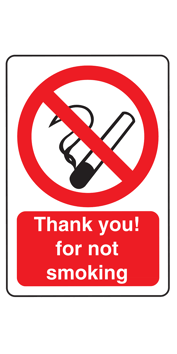
For as many as 8 out of 10 patients reading this article, your COPD is due to years of heavy or even light smoking. There are many articles showcasing the severe impact cigarettes have on lung function. However, if you have COPD and are still smoking this will be yet another reason to put down the cigarettes.
In addition to expediting the progression of COPD and worsening symptoms, nicotine has also been shown to cause breathlessness inducing panic attacks in certain people.
Though it’s often difficult for patients to quit due to addiction, or because smoking is often used as a stress or anxiety relief tactic when faced with stressful situations. If you are having difficulty quitting, don't give up and keep in mind that your body will begin to repair itself in as little as 20 minutes after quitting. Speak with your doctor about possible smoking cessation aids.
13) Eat a Well Rounded Nutrient Rich Diet
Eating a nutrient balanced diet will not only help you maintain a healthy weight to prevent exacerbating your COPD symptoms, it can also improve your mental health. By cutting out unhealthy foods, you will have an improved self-image.
Furthermore, eating sugary and empty calorie foods, including caffeinated and alcoholic beverages will drain your daily energy levels and only add onto your chronic stress levels.
Instead, you should nourish your body with COPD conscious nutrients that include fresh fruits and vegetables, lean-meats & fish, whole grains, and dairy products (unless instructed otherwise).
14) Anti-Anxiety Medications
If anxiety continues to worsen, speak to your doctor about possible anti-anxiety medications to see if they would benefit you. It’s also important to mention anti-depressants to your doctor, as they are sometimes more effective. However, you may find otherwise and should use the medication that is most effective for stress reduction.
15) Write Your Thoughts in a Anxiety and Panic Attack Diary
Keeping track of your stressful moments in a anxiety and panic attack diary can help improve your anxiety management and reduce your overall chronic stress levels in the long term. By keeping track of triggers, symptoms, and progress, you will be able to reexamine your entries to find out what you should avoid to prevent inducing a symptom worsening anxiety or panic attack.
What you should include in your anxiety and panic attack diary:
- Jot Down Your Physical Symptoms - Make a column in your diary titled “physical symptoms”. These vary from patient to patient, but take note of any induced symptoms no matter their severity. Commonly these can include increased shortness of breath, chest pain, excessive sweating, or shaking.
Once your panic attack has subsided, reflect on the physical symptoms you experienced. You may only be able to think of a few, but as you begin writing more may come to mind. - What Were your Thoughts, Fears, and Emotions - In addition to the physical symptoms you experienced, a panic attack can also induce fearful or improbable thoughts. As a COPD patient this may include thinking you’re dying due to worsening shortness of breath.
Be sure to record all of the emotions you felt during the panic attack. Were you angry, sad, fearful, confused, or anxious? No matter how minor you think the thought, fear, or emotion is write it down in your panic attack diary. - Specific Environment and Current Life Events - Where were you or what life event caused your panic attack? Knowing the specific environments or situations in which you experienced your panic attacks is an effective method to find the source of your anxiety triggers.
A few examples of anxiety triggers could be driving, overcrowded stores, confined areas, or sporting events. It’s also important to take not of any personal issues that may be going on such as fighting with a family member or longtime friend, difficulties at work, or being recently diagnosed with a chronic lung disease. - Techniques You Used to Cope - What did you use to help manage your panic attack? Did you use specific stress management techniques such as deep breathing exercises, visualization, relaxation exercises, yoga, Tai Chi, or talking to your support group?
Take note of every option you used to help get through your panic attacks. This way you can refer back it in the future to find the exact techniques you used to cope with anxiety and combat previous panic attacks.
Not only will writing in an anxiety and panic attack diary help you better manage future attacks and diagnose your personal stressors, but you can also share your diary with your doctor.
Allowing them to assess your personal stressors and which techniques were most effective for treatment so they can better understand what does and does not work for you. Your panic diary can be an essential treatment resource but only if you take the time to keep it updated.
16) Practice Makes Perfect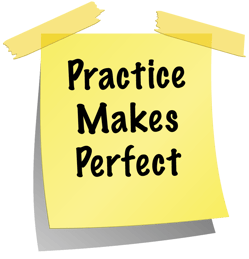
We cannot stress the importance of practicing these stress management techniques everyday, multiple times a day. After all, practice makes perfect!
By regularly practicing the stress reducing techniques discussed above, you can easily recall how to properly do them when faced with stressful situations to receive the most benefits. Don’t wait until the onset of a panic attack to try and remember how to do these techniques. Be prepared for the unexpected and PRACTICE!
17) Accept That Certain Things are Out of Your Control
Modify Your Thoughts from “COPD is the worst thing, and my anxiety is uncontrollable” to “Though both COPD and anxiety are frustrating, I know I will be okay and can manage this”.
Feelings follow thoughts, so though you have a progressive and restrictive respiratory disease it’s important that you understand certain things are out of your control. Stop focusing on the negative aspects of your COPD and focus on the positives.
Conclusion
Stress, it’s an aspect that many of us have to deal with, some more than others. But stress, anxiety, and panic attacks that occur in patients with COPD cause far greater complications.
Leaving chronic stress levels untreated increases your odds of experiencing a COPD exacerbation. Combat the mental and physical effects of your COPD related stress by applying the 17 stress relief techniques from above into your daily treatment for COPD.
How do you relieve stress? Specifically, which stress management techniques provide you with the most benefit and which are least effective? Leave a comment below with your stress relief tactics.


